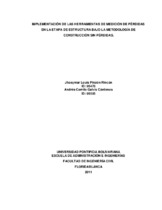Implementación de las herramientas de medición de pérdidas en la etapa de estructura bajo la metodología de construcción sin pérdidas

View/
Date
2014-09-10xmlui.dri2xhtml.METS-1.0.item-advisor
Tijo López, Silvia Juliana
xmlui.dri2xhtml.METS-1.0.item-type
bacherlorThesis
Citación
Metadata
Show full item recordDocuments PDF
Abstract
A lo largo de los años la industria de la construcción, a diferencia de otras industrias ha mantenido sus procesos productivos casi intactos, conservando consigo todos sus desperdicios de materiales y mano de obra. Otras industrias como la automotriz han desarrollado metodologías para mejorar sus procesos y hacerlos más eficientes, estas han sido transformadas y adecuadas para poder ser usadas en el sector de la construcción y aunque han tenido grandes resultados en otros países, las constructoras Colombianas han sido muy escépticas al cambio, el cual ha sido lento y progresivo. En este trabajo se analizaron procesos constructivos de la etapa de estructura tipo tradicional y tipo túnel de una constructora de la ciudad de Bucaramanga, estos previamente seleccionados y caracterizados según su importancia, la medición se hizo por medio de mediciones de 5 minutos realizadas aleatoriamente a los empleados que estaban dedicados a las actividades a analizar. Consecutivamente se clasificaron los datos en diferentes categorías de pérdidas y se propusieron mejoras, las cuales fueron verificadas por medio de otra ronda de mediciones de 5 minutos, para poder dar así unas observaciones finales. Finalmente se pudo concluir que la estructura tipo tradicional genera menos tiempos productivos y mas no contributivos que la estructura tipo túnel, además de visualizarse la necesidad de la implementación de la herramienta LastPlanner para mejorar la planificación de la obra y estabilizar el comportamiento de los tiempos. Over the years the construction industry, unlike other industries has remained almost intact its production processes, keeping them all their waste materials and workforce. Other industries such as self-propelling have developed methodologies to improve processes and make them more efficient, these have been transformed and suitable to be used in the construction area and even they have had great results in other countries, Colombian builders have been very skeptical to the change, which has been slow and progressive. In this document we analyzed the construction processes in the stage of structure of the traditional type and tunnel of a construction company of the city of Bucaramanga, these previously selected and characterized according to their importance, the measurement was made by measurements made 5 minutes randomly in employees who were engaged in the activities to be analyzed. Consecutively these data were classified into different categories of losses and were proposed improvements, which were verified by another round of measurements of 5 minutes, in order to give concluding remarks. Finally it was concluded that the structure of the traditional type generates less productive times and more noncontributive tomes as the tunnel type structure, as well as were visualized the needing for implementing the Last Planner tool to improve the planning of the work and stabilize the behavior of the times.
Keyword/s
Ingeniería civil
Construcción
Estudio de tiempos
Administración del tiempo
Procesos de manufactura
Recursos humanos
Costo de mano de obra
Collections
- Trabajos de grado [6348]

